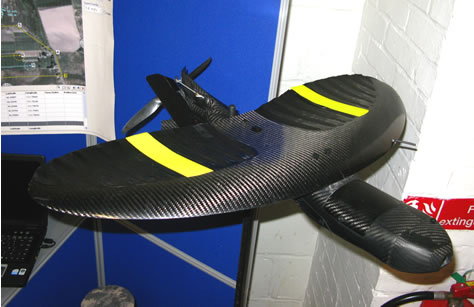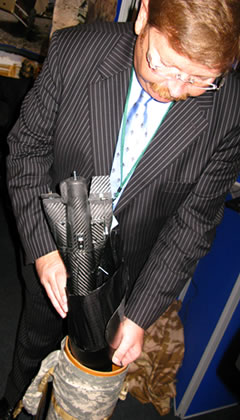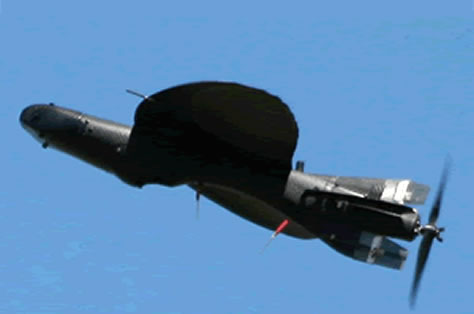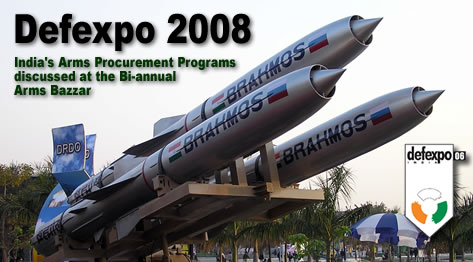The Indian Ministry of Defense is planning to double its arms procurement and spend over US$ 20 billion (over Rs 120,000 crore) – more than twice the amount spent in the past 10 years on an annual basis. In the next four years, on the procurement of new weapons and hardware, these opportunities would probably be the highlights of Defexpo 2008 and Air Power India conference, that took place in New Delhi in February 2008. The conference was sponsored by Defense Update. About 450 companies are participating in DefExpo maritime and land warfare exhibition, of which about 300 are international defense industries from 30 countries.
Russia, India’s largest arms supplier has ongoing contracts worth about US$15 billion, representing about 60% of India’s recent arms imports. Russian Prime Minister Viktor Zubkov arrived in India this week (February 12) for the opening ceremony of the Year of Russia in India and promoting military-technical cooperation. In past years Russia provided India almost all the arms it required but in recent years New Delhi has widened its gates for other suppliers, from Europe, Israel and most lately – the USA. As a result, Indo-Russian arms cooperation is under pressure, as international defense manufacturers attracted to the sub-continent’s lucrative arms market.
On the table are major naval acquisition programs, including buying six submarines for abut $2.3 billion and $3 billion worth modernizations of India’s artillery corps. The later could include 140 light howitzers, 400 towed 155mm guns and 180 truck-mounted self propelled guns. India continues to buy Russian Su-30MKI and T-90S tanks and is expected to produce about a thousand supersonic Brahmos-1 missiles, developed and produced under an Indo-Russian cooperation. Development of a future hypersonic version of the missile dubbed Brahmos-2 is already underway. The Navy has three new frigates on order, these are also planned to be equipped with the Brahmos. Refitting of the Russian Navy aircraft carrier Admiral Grushkov for the Indian Navy is also in the planning. The two countries signed a contract worth $1.2 billion for the modernization but since signing the contract, the cost of the program was escalated dramatically, affected by cost raw materials, exchange rate and cost of work. At present Russia demands $1.5 more for the work.
Air defense programs are also shifting away from traditional Russian systems. As India is developing an indigenous air defense system – the Akash, it also selected systems for future replacement of the SA-3 (Pechora), dropping plans to upgrade the aging Russian missiles. Conclusion of the long overdue procurement of Israeli Spyder short-range air defense systems is nearing, while additional deals are underway with IAI, for a joint development and production of a land-based derivative of the Barak-8 advanced naval air and missile defense missile.
By far the largest program is the planned procurement of 126 multi-role combat aircraft (MRCA) for the Indian Air Force, as part of a US$10 billion buy. But other programs are also making attractive prospects for international aerospace and defense manufacturers. New Delhi is currently evaluating the Boeing F/A-18E/F, Dassault Rafale, Eurofighter Typhoon, Lockheed Martin F-16, Saab Gripen, MiG-35 and Sukhoi Su-35. Formal submissions of proposals are expected within a month. (March 2008). Regardless of the winner of the MRCA competition, India is participating in the development of a fifth generation Russian fighter aircraft and is expected to share future production to equip its air force units sometime in the next decade.
Only few weeks after scrapping a 197 helicopter contract, won by EADS’ division Eurocopter, New Delhi is launching a new tender for the supply of 312 light military helicopters, as the Air Force merged its requirement for future light helicopters with the Army and navy. The Indian Air Force also plans to acquire two squadrons of modern attack helicopters and about six heavy lift helicopters. The light helicopters will replace the Chetak and Cheetah helicopters (license built Alouette II and III). Replacement of these 30 year veterans was planned for next year but due to the new procedure, it is expected to begin only in 2011, the earliest.
Under a parallel program, the IAF approved a contract to buy six Lockheed martin C-130J transport aircraft in a deal worth one billion dollars. These aircraft are intended for India’s special forces. The Indian Navy is in final contract negotiations for the procurement of eight Boeing P-8i Posedon Long-range maritime reconnaissance (LRMR) worth about two billion dollars. India also considered an alternative platform based on the Airbus A-319 but finally opted for the U.S. aircraft. Given these two contracts are signed this year, the U.S. could become India’s largest weapon supplier surpassing Russia and Israel which average US$1.5 and US$1 billion sales per year in recent years. The UK is also sharing the prosperity of the Indian shopping spree. BAE Systems is also being rewarded for their patience and dedication in their 18 year the Hawk trainer, In 2004 British Aerospace signed a contract to deliver 66 aircraft worth about US$1.45 billion dollars. India is now planning to order 40 additional Hawks to strengthen its advanced trainer fleet.
New Naval Systems
India is planning the acquisition of acquiring six new hunter-killer submarines and seven new frigates. India is already building six French designed Scorpene class diesel electric powered subs, scheduled to enter service in the next decade. The new submarine is expected to be larger than the current Scorpene, and its armament suite is expected to include a larger land attack missile, considered to be part of the country’s strategic deterrence triad. The new submarine program is expected to draw the same companies only recently competed for the current program, including French naval company DCNS, Spanish Navantia, the German submarine building consortium HDW and Russian submarine builder Rubin. India currently has 16 submarines in service and in production, part of them are Russian Amur class subs.
A different program currently taking shape is the Navy’s Project 17A, in which the Indian Navy plans to introduce seven new frigates. The Indians are expected to evaluate several designs, including U.S, European and Russian designs.
Opening to International Cooperation
As already mentioned here, two of the leading aerospace programs offered by Lockheed Martin are the F-16I multi role fighter and C-130J tactical transport. Other systems offered to India are the Sniper advanced targeting pod and Hellfire II guided missiles. Lockheed Martin believes that India could be the largest defense market in Asia with $20 billion in possible air force, navy and communications contracts over the next decade, an executive said on Tuesday. “For Lockheed Martin, the potential market in India is probably the largest in Asia Pacific,” Richard Kirkland, Lockheed Martin’s President South Asia, told Reuters on the sidelines of the Singapore Airshow. Last month the company announced the planned sale of six C-130J Hercules transport planes to India as part of a $1 billion sale. India has an option to add six more aircraft to its order. Lockheed Martin is also competing on the MRCA program and plans to respond to an upcoming Indian bid for surface vessels, for which it is ready to offer the AEGIS weapon system, and submarine modernization as well as communications programs. Lockheed Martin is also promoting the Patriot PAC-3 to satisfy New-Delhi’s air and missile defense requirements. For naval air defense, Washington is also offering various tactical missiles and precision engagement systems based on the MLRS/GMLRS system.
Northrop Grumman promoted the advanced Hawkeye (E-2D) at DefExpo 2008. This aircraft will be able to provide aerial early warning and control to air and surface elements operated by the Indian Navy, over land and at sea. Another systems promoted by Northrop Grumman in India is the FireScout RQ-8B, vertical Takeoff and Landing UAV. Northrop Grumman is also offering some of its naval vessel designs to India, primarily the LPD 17 San Antonio class amphibious transport ship, and corvette size offshore patrol frigate, based on the coast-guard Cutter being built in the U.S.
France was the second largest participant at Defexpo 2008. Both Indian Air Force and Navy are currently operating French systems. The IAF flies the French Dassault Mirage 2000 with two squadrons, which are to be upgraded in the upcoming year to sustain 25 additional years in service. Six French designed Scorpene class submarines are currently being built for the Indian Navy, at the state-owned Mazgaon Dockyard. France is hoping to receive a follow-on order for six additional subs later this year. The French Thales group is also scheduled to begin the upgrade six of the Indian Navy’s Soviet-era minesweepers. AgustaWestland, member of the Italian Finmeccanica group is interested in competing for the expected tender to supply new helicopters to the Indian Navy.
As India opens its doors for cooperation with multinational and foreign defense contractors it has also enforced tougher offset rules, requiring foreign suppliers to spend 30% of each program with local industries. Therefore, DefExpo 2008 is providing a meeting point where between local industries and foreign companies can where they can locate local partners to fulfill their offset obligations. On the long run, this move is expected to infuse more capabilities and technologies to India’s domestic defense industries.
The government is also changing some rules of the sales process, revamping its Defense Procurement Policy (DDP) by introducing a new mechanism to register arms agents, therefore streamlining their activities both domestically and overseas. This could avoid scandals such as the recent cancellations and delays experienced on multiple contracts.
Joint Ventures Announced
Privately owned companies partly owned by foreign enterprises can now compete for defense contracts if the equity owned by the foreign entity is les than 26%. Furthermore, under the new regulations to enter by April 2008, some private firms will be entitled to the same benefits and tax exempts currently reserved to government owned companies. Large companies such as Tata Power, Larsen & Tourbo, Mahindra & Mahindra and Bharat Electronics are well positioned to benefit from these regulations and have already launched joint ventures with foreign corporations. The Defense Research & Development Organization is going to acquire a new role of a scientific center. It will also be the main distributor of orders to private companies.
The French naval company DCN announced plans to establish an India-based subsidiary called DCNS India, to be based Mumbai. The new company is expected to link up with Indian joint venture partners capable of offering specialized services, design and maintenance contract. DCNS already partners Mumbai’s state-owned Mazagon Dock Ltd. in building six Scorpene submarines for the Indian Navy. The company is scheduled to deliver the first submarine by 2012 and subsequent submarines every year over the next five years. Scorpene submarines, fitted with BrahMos missiles, could be part of the mix of conventional and nuclear undersea firepower that India proposes to acquire over the next decade. Indian Navy is likely to lease a nuclear submarine from Russia next year. DCNS has recently signed agreements with Kirloskar Oil Engines for integrated platform management systems and with Walchandnagar Industries Ltd. propulsion system parts for the next generation ASW (anti-submarine warfare) corvettes being built for the Indian Navy.
A joint venture has already been signed with Italy’s Whitehead Alenia Sistemi Subacquei (WASS), a subsidiary of the Finmeccanica Group and Bharat Electronics, to develop underwater weapon systems. WASS is promoting its Black Shark heavyweight torpedo for the Indian Scorpene submarines. The company has an ongoing cooperation with India’s Bharat Dynamics in the underwater systems sector. A different division of the Indian company – Bharat Heavy Electricals Ltd has obtained from Oto Melara a licence to produce 76mm naval cannons. This licence could be extended to cover production of 127mm cannons, which are currently the subject of a tender process for installation on the Indian Navy’s new class of destroyer.
One of India’s leading vehicle manufacturers, Mahindra & Mahindra, is expecting to capture up to 60% of the military vehicle’s requirements estimated at $5 billion over the next decade. The bids are likely to be made through the company’s subsidiary Mahindra Defense Systems by forming joint ventures with global equipment manufacturers.
Indo-Israeli Relations Tightened
Relations between Israel and India have improved in the last decade, particularly after the Kargil war, when Israel rushed special assistance to aid India in time of war. Since then, India invested massively in military buildup, becoming Israel’s largest defense export destination in Asia. Bilateral relations, which were sofar based on government-to-government basis, have recently been expanded to the industrial and business sector, as Israeli defense industries are establishing Joint Ventures (JV)s to promote their interests in the subcontinent, improving their ability to meet New Delhi’s new offset regulation. Some of these JVs were announced at DefExpo 2008 exhibition in February.
Rafael announced preliminary agreement to establish a joint venture company with Bharat Electronics Ltd, India’s largest defense electronics company. The new JV will focus primarily on defense electronics associated with missile systems. Elbit Systems already has a JV with BEL, focusing primarily on electro-optics and thermal imaging systems. Last year Elbit Systems has also launched the HALBIT JV with Hindustan Aeronautics Ltd (HAL) and and Merlin Hawk Associates Pvt Ltd, focusing on avionics parts and simulation systems for military and commercial applications.
Israel Aerospace Industries has an ongoing cooperation with several Indian companies, among them cooperative development and international marketing associated with helicopters and other aerospace systems; IAI recently also chose an Indian satellite launcher to carry its latest radar equipped spy satellite Tecsar into orbit. This week IAI signed an memorandum of understanding (MOU) with the Tata Group, for the establishment of a JV associated with aerospace and defense. The joint company will focus on development, production, and providing customer support for a wide range of products, including missiles, unmanned systems, radars and electronic warfare systems used for military and homeland security applications. Other joint activities are still shrouded by secrecy, under the Indian-Israeli defense cooperation agreement.
Tata Industries announced an agreement for jointly exploring opportunities with Urban Aeronautics, an Israeli designer of innovative vertical take-off and landing aerosystems. Tata has also decided to invest in the Israeli company. Tata is interested in local production and marketing of Urban Aviations’ Fancraft technology for the Indian market. Urban Aviation is exploring several applications of the Fancraft technology, including a twin turbine powered transportier capable of carrying 12 people, a single turbine powered unmanned aircraft for with payload capacity of 250 kg and a small, electrically powered surveillance mini UAV.
The following articles are included in this review:










 Text based information resources such as email and articles can be used with text processing applications such as SAS Text Miner (picture here), to uncover information hidden in document collections, by analysing a elements with common intelligence values and predictive models.
Text based information resources such as email and articles can be used with text processing applications such as SAS Text Miner (picture here), to uncover information hidden in document collections, by analysing a elements with common intelligence values and predictive models.
















